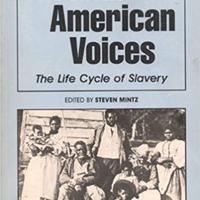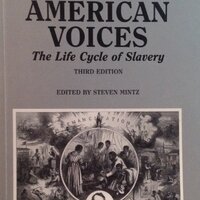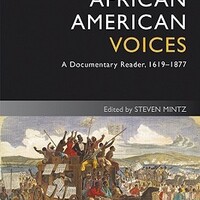African American Voices (ed. Mintz, 2nd ed.)
Item
-
Title
-
African American Voices (ed. Mintz, 2nd ed.)
-
This edition
-
"African American Voices: The Life Cycle of Slavery." Ed. Stephen Mintz. 2nd ed. St. James, NY: Brandywine Press, 1999. xi+227 pp.
-
Other editions, reprints, and translations
-
● "African American Voices: The Life Cycle of Slavery." Ed. Steven Mintz. St. James, NY: Brandywine Press, 1993. ix+178 pp.
-
 African American Voices (ed. Mintz)
African American Voices (ed. Mintz)
-
● "African American Voices: The Life Cycle of Slavery." Ed. Steven Mintz. Rev. ed. St. James, NY: Brandywine Press, 1996. ix+212 pp.
-
● "African American Voices: The Life Cycle of Slavery." Ed. Stephen Mintz. 3rd ed. St. James, NY: Brandywine Press, 2004. xi+233 pp.
-
 African American Voices (ed. Mintz, 3rd ed.)
African American Voices (ed. Mintz, 3rd ed.)
-
● "African American Voices: A Documentary Reader, 1619-1877." Ed. Stephen Mintz. 4th ed. Malden, MA: Wiley-Blackwell, 2009. xiv+241 pp.
-
 African American Voices (ed. Mintz, 4th ed.)
African American Voices (ed. Mintz, 4th ed.)
-
Table of contents
-
(2nd ed. 1999)
Preface to the Second Edition (ix)
Foreword (xi)
● Steven Mintz / Introduction: A History of Slavery (1)
Chapter 1: ``Death's Gwineter Lay His Cold Icy Hands on Me'': Enslavement: (41)
● A Portuguese chronicler, Gomes Eannes de Azurara, describes the capture of the first African slaves by Europeans (1453) (43)
● A European slave trader, John Barbot, describes how slaves are procured (1682) (44)
● An European trader, William Bosman, describes relations between European slave traders and their African counterparts (1705) (48)
● An English explorer, Francis Moore, describes the process by which people are enslaved (1738) (51)
● A Muslim merchant, Ayabah Suleiman Diallo, recalls his capture and enslavement (1734) (52)
● Olaudah Equiano, an eleven-year-old Ibo from Nigeria remembers his kidnapping into slavery (1789) (55)
● A British slave captain, William Littleton, is questioned about whether Europeans foment war in order to acquire slaves (1789) (57)
● A European explorer, Mungo Park, describes how the slave trade functioned (1797) (59)
● Venture Smith relates the story of his kidnapping at the age of six (1798) (60)
Chapter 2: ``God's A-Gwineter Trouble de Water'': The Middle Passage (67)
● A European sailor, James Bardot, Jr., describes a shipboard revolt by enslaved Africans (1700) (69)
● An English captain, William Snelgrave, describes the precautions that slavers must take in order to prevent shipboard rebellions (1721) (72)
● Olaudah Equiano describes the horrors of the Middle Passage (1789) (75)
● A doctor, Alexander Falconbridge, describes conditions on an English slaver (1788) (78)
Chapter 3: ``Weary Traveler'': Arrival in the New World (85):
● Olaudah Equiano describes his arrival in the New World (1789) (87)
● An English physician, Alexander Falconbridge, describes the treatment of newly-arrived slaves in the West Indies (1788) (88)
Chapter 4: "We Raise de Wheat, Dey Gib Us de Corn": Conditions of Life (91)
● Solomon Northrup describes the working conditions of slaves on a Louisiana cotton plantation (1853) (93)
● Charles Ball compares working conditions on tobacco and cotton plantations (1858) (94)
● Josiah Henson describes slave housing, diet, and clothing (1877) (97)
● Francis Henderson describes living conditions under slavery (1856) (98)
● Jacob Stroyer recalls the material conditions of slave life (1898) (100)
● James Martin remembers a slave auction (1937) (101)
Chapter 5: "Like a Motherless Child": Childhood (103)
● Jacob Stroyer recalls the formative experiences of his childhood (1898) (105)
● James W. C. Pennington analyzes the impact of slavery upon childhood (1849) (107)
● Lunsford Lane describes the moment when he first recognized the meaning of slavery (1842) (109)
Chapter 6: "Nobody Knows de Trouble I See": Family (111)
● Laura Spicer learns that her husband, who had been sold away, has taken another wife (1869) (113)
● An overseer attempts to rape Josiah Henson's mother (1877) (114)
● Lewis Clarke discusses the impact of slavery on family life (1846) (117)
Chapter 7: "Go Home to My Lord and Be Free": Religion (119)
● Olaudah Equiano describes West African religious beliefs and practices (1789) (127-29)
● Charles Ball remembers a slave funeral, which incorporated traditional African customs (1837) (130)
● Peter Randolph describes the religious gatherings slaves held outside of their masters supervision (1893) (130-32)
● Henry Bibb discusses ``conjuration'' (1849) (133-36)
Chapter 8: "Oppressed So Hard They Could Not Stand": Punishment (131)
● Frederick Douglass describes the circumstances that prompted masters to whip slaves (1845) (133)
● John Brown has bells and horns fastened on his head (1855) (134)
● William Wells Brown is tied up in a smokehouse (1847) (135)
● Moses Roper is punished for attempting to run away (1837) (136)
● Lewis Clarke describes the implements his mistress used to beat him (1846) (138)
Chapter 9: "Let My People Go": Resistance (139)
● Frederick Douglass resists a slave breaker (1845) (141)
● Nat Turner describes his revolt against slavery (1831) (146)
Chapter 10: "Follow the Drinkin' Gourd": Flight (151)
● Margaret Ward follows the North Star to freedom (1879) (153)
● Frederick Douglass borrows a sailor's papers to escape slavery (1855, 1895) (156)
● Harriet Tubman sneaks into the South to free slaves (1863, 1865) (158)
● Henry ``Box'' Brown escapes slavery in a sealed box (1872) (161)
● Margaret Garner kills her daughter rather than see her returned to slavery (1876) (163)
Chapter 11: "The Walls Come Tumblin' Down": Emancipation (167)
● Private Thomas Long assesses the meaning of black military service during the Civil War (1870) (169)
● Corporal Jackson Cherry appeals for equal opportunity for former slaves (1865) (170)
● Jourdan Anderson declines his former master's invitation to return to his plantation (1865) (170)
● Major General Rufus Saxon assesses the freedmen's aspirations (1866) (172)
● Colonel Samuel Thomas describes the attitudes of ex-Confederates toward the freedmen (1865) (174)
● Francis L. Cardozo asks for land for the freedmen (1868) (175)
● The Reverend Elias Hill is attacked by the Ku Klux Klan (1872) (176)
● Henry Blake describes sharecropping (1937) (178)
● Frederick Douglass assesses the condition of the freedmen in 1880 (179)
Bibliographical Essay (181)
A Bibliography of Recent Works in English: Slavery and Antislavery (187)
-
Reviews and notices of anthology
-
● "Book Notes." "Journal of Negro History" 86.1 (2001): 74.
-
Item Number
-
A0480c
 African American Voices (ed. Mintz)
African American Voices (ed. Mintz)
 African American Voices (ed. Mintz, 3rd ed.)
African American Voices (ed. Mintz, 3rd ed.)
 African American Voices (ed. Mintz, 4th ed.)
African American Voices (ed. Mintz, 4th ed.)
 African American Voices (ed. Mintz, 3rd ed.)
African American Voices (ed. Mintz, 3rd ed.) African American Voices (ed. Mintz, 4th ed.)
African American Voices (ed. Mintz, 4th ed.) African American Voices (ed. Mintz)
African American Voices (ed. Mintz)
